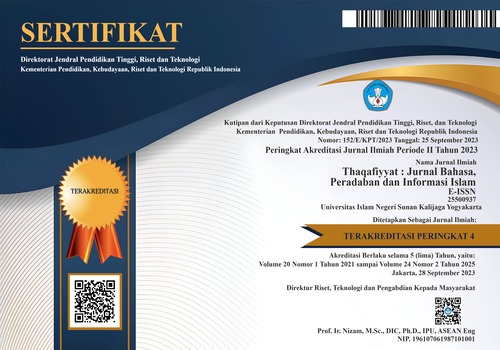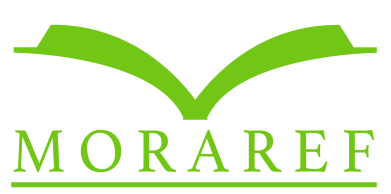TATA RUANG DAN KERUANGAN KOMPLEKS MAKAM KOTAGEDE (SINKRETISASI BUDAYA JAWA DENGAN ISLAM)
DOI:
https://doi.org/10.14421/thaq.2018.19205Kata Kunci:
Tombs, spatial planning, syncretization, Java, and IslamAbstrak
This article explores the tombs in the compound of mosque and Islamic Mataram cemetery in Kotagede. The object used for the research is the tomb complex which is located behind the Kotagede mosque. The main figure buried in the cemetery is Panembahan Senopati and some of his close relatives. The research is conducted due to the pattern of placement and arrangement of the tombs which is interesting as an object of study. Certain patterns are found in the use of space in the tomb complex, both horizontally and vertically. Further studies are needed to see whether the pattern have to do with the concept of habluminallah and habluminanas? Certainly, these patterns could be the influence of Islam in the Javanese culture. This is quite understandable since the tomb concept maker is the main figure of Islamic Mataram kings, i.e., Panembahan Senopati.)
Unduhan
Referensi
Arief Furqhan, Pengantar Metode Penelitian Kualitatif, Surabaya: Usaha Nasional, 1992.
Ayat Rohaedi (ed.), Kepribadian Budaya Bangsa, Jakarta: Dunia Pustaka Jaya, 1986.
Cholid Narbuko dan H. Abu Achmadi, Metodologi Penelitian (Jakarta: Bumi Aksara, 2002.
Deddy Mulyana, Metodologi Penelitian Kualitatif: Paradigma Baru Ilmu Komunikasi dan Ilmu Sosial Lainnya, Bandung: Remaja Rosdakarya, 2003.
Dharsono (Sony Kartika), Budaya Nusantara; Kajian Konsep mandala dan Konsep Tri-loka Terhadap Pohon Hayat pada Batik Klasik, Bandung: Rekayasa Sains, 2007.
Eliade, Mircea, Sakral dan Profan, terj. Oleh Nuanto, Yogyakarta: Fajar Pustaka Baru, 2002.
Geertz, Cliford, Abangan, Santri, dan Priyayi dalam Masyarakat Jawa, terj. Aswab Mahasin dari The Religion of Java, Jakarta: Dunia Pustaka Jaya, 1981. Harapandi Dahri, Wali dan Keramat dalam Islam, Jakarta: Balitbang Depag, 2007.
Graaf, H.J. de, dan T.H. Pigeaud, Kerajaan Islam Pertama di Jawa; Tinjauan Sejarah Politik Abad XV dan XVI , cet. ke 5, Jakarta: Graffiti dan KITLV, 2003.
Heddy Shri Ahimsa-Putra, ”Pengantar” dalam Octavio Paz, Levi-Strauss Empu Antropologi Struktural, Yogyakarta: LKIS, 2001.
Inajati Adrisijanti, Arkeologi Perkotaan Mataram Islam, Penerbit Jendela: Yogyakarta, 2000.
Imam Suprayogo dan Tobroni, Metodologi Penelitian Sosial-Agama, Bandung: Remaja Rosdakarya, 2003.
Koentajaraningrat, Pengantar Ilmu Antropologi, Jakarta: Aksara Baru, 1980.
Moh. Nazir, Metode Penelitian, Jakarta: Ghalia Indonesia, 1988.
Muhaimin AG, Islam dalam Bingkai Budaya Lokal Potret dari Cirebon, Jakarta: Logos, 2002.
Mulder, Niels, Kepribadian Jawa dan Pembangunan Nasional, Yogyakarta:Gadjah Mada University Press, 1984.
Ngakan Ketut Acwin Dwijendra, Arsitektur Rumah Tradisional Bali, Denpasar: Universitas Udayana Press, 2008.
Pramana, Sugeng, Ki Ageng Mangir; Berjuang Melawan Hegemoni Mataram, Yogyakarta: Gelombang Pasang, 2006.
Radjiman, Koonsep Petangan Jawa, Surakarta: Yayasan Pustaka Cakra, 2000.
Revianto Budi Santosa, Omah; Membaca Makna Rumah Jawa, Yogyakarta: Yayasan Bentang Budaya, 2000.
Simuh, Mistik Islam Kejawen Raden Ngabehi Ranggawarsito; Suatu Studi terhadap Wirid Hidayat Jati, Jakarta: UI Press, 1996.
Suharsimi Arikunto, Prosedur Penelitian: Suatu Pendekatan Praktek, Edisi Revisi V, Jakarta: Rineka Cipta, 2002.
Suwardi Endraswara, Metode, Teori, Tehnik Penelitian Kebudayaan: Ideologi, Epistemologi, dan Aplikasi, Yogyakarta: Pustaka Widyatama, 2006.
Tjejep Rohendi Rohidi, Kesenian dan Pendekatan Kebudayaan, Bandung: STSI Press, 2003.
Triyanto, Makna Ruang dan Penataanya Dalam Arsitektur Rumah Kudus Semarang: Kelompok Studi Mekar, 2001.
Y. Tri Subagya, Menemui Ajal; Etnografi Jawa tentang Kematian, Yogyakarta: Penerbit Kepel Press, 2007.
Unduhan
Diterbitkan
Terbitan
Bagian
Lisensi
Hak Cipta (c) 2020 Riswinarno

Artikel ini berlisensiCreative Commons Attribution-NonCommercial-ShareAlike 4.0 International License.
Authors who will publish with this journal agree to the following terms:
- Thaqafiyyat: Jurnal Bahasa, Peradaban dan Informasi Islam publishes all articles entirely in full text.
- It is permissible for readers to download and to use it for scientific purposes and scientific dissemination.
- Authors retain copyright and grant the journal right of first publication with the work simultaneously licensed under a Creative Commons Attribution License that allows others to share the work with an acknowledgement of the work's authorship and initial publication in this journal.
- Authors are able to enter into separate, additional contractual arrangements for the non-exclusive distribution of the journal's published version of the work (e.g., post it to an institutional repository or publish it in a book), with an acknowledgement of its initial publication in this journal.
- Authors are permitted and encouraged to post their work online (e.g., in institutional repositories or on their website) prior to and during the submission process, as it can lead to productive exchanges, as well as earlier and greater citation of published work.









